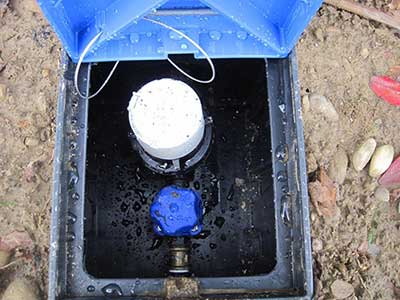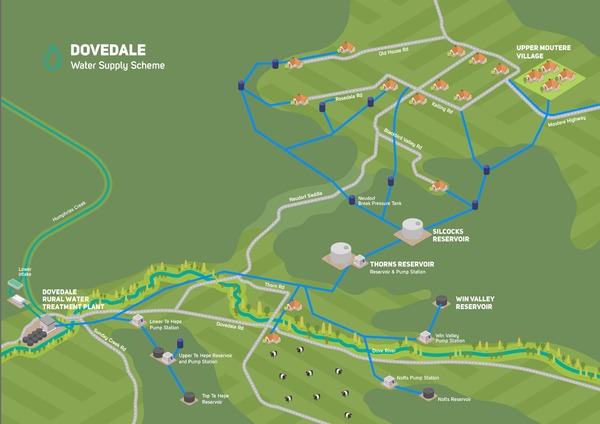Application Form - New water connection or change to water supply (pdf 681 KB)
If you are building or subdividing and you need to apply for a new connection to any of our water, stormwater or wastewater schemes, download and return the application form to [email protected].
You can also use this form for reducing water allocations or transferring units on rural schemes. For unit reductions or disconnections on our rural schemes or extension: applications need to be received before the end of May to ensure changes are completed before the financial year end (30 June), or another year of rates will be incurred.
Read the Water and Wastewater Connection Policy (pdf 185 KB), which guides Council practice in relation to water supply connections.
Learn how to manage your water meter; allowing you to monitor and control your water usage and detect leaks, which saves you money and our precious water resources.
Water meters are usually located below ground level in a box near the road boundary of your section. There is a shut off valve in the meter box so you can turn your water off for any plumbing repairs.
It is a good idea to check your water meter regularly to ensure you have no leaks.
Reading the water meter is a simple task. There are eight numbers: The four on the left record whole cubic metres, the four on the right in bold record parts of a cubic metre (litres).
2 4 0 6 3 9 0 5 shows you have used 2406.3905 cubic metres (m3) of water. Put another way, you have used 2,406 cubic metres and 390.5 litres of water. A cubic metre equals 1,000 litres or 220 gallons.
When it comes to charging, only the black numbers (cubic metres) are read and will appear on your water account.

Water meter readings when you sell your house.
In order to prepare a final bill for the property you have sold, you should notify the Council for a final reading of your water meter when you move out. These special readings are done weekly and an extra charge applies. Also, remember to check that the meter is being read at the house you are moving into.
Old metal fittings in some water supplies can mean minute traces of lead may be present in your household tap water.
Research carried out by the Institute of Environmental Science and the Ministry of Health has shown that some New Zealand water supplies contain minute traces of lead that are near to or exceed the maximum acceptable level specified in the New Zealand Drinking Water Standards. Traces of metals - in particular lead - are of concern because over time they pose a potential health risk, especially if consumed from childhood.
It is important to note that the lead is not coming from the water supplies themselves, but primarily from metals in some household fittings that may be dissolved into the water. The amount of lead that will dissolve from a fitting depends on how plumbosolvent* the water is; the temperature of the water; the composition of the plumbing fittings and how long the water has been in contact with it.
The fact that most New Zealand waters are of very good quality and contain little dissolved substances such as calcium and magnesium salts contributes to their plumbosolvency, which is widespread in New Zealand. The Ministry of Health therefore recommends that people do not drink the first mugful of water if their tap has not been used for several hours ie, overnight for instance.
Instead, people should run the tap for a second or so, which will quickly flush away any water that has become contaminated with lead or any other metals from the plumbing fittings. The Ministry of Health works closely with Standards New Zealand and the plumbing industry in New Zealand to develop quality standards for plumbing fittings.
Additional details on this issue can be sourced from the Taumata Arowai website.
* plumbsolvent = The types of water that have the ability to dissolve lead (usually soft waters) are known as ‘plumbsolvent’ because of their ability to dissolve lead (from the Latin word plumbum).
In an emergency, you can hand-chlorinate private drinking water tanks.
You can hand chlorinate your water tanks with household bleach if they become contaminated/receive untreated water.
You should use plain, non-fragranced non-coloured bleach, ideally one which has no added agents.
Budget plain household bleach and Chlor-o-gene are two brands that are suitable. Janola does have added chemicals, but can still be used in an emergency.
The table below shows how much chlorine you should add to a tank full of water. The dose is in ml (millilitres) and so can be measured using a kitchen measuring jug. Wear rubber gloves when dosing chlorine.
Chlorine will not kill protozoa, which is a risk posed by sewage contamination. If in any doubt, boil your water before drinking until you are certain it’s safe to use. Once the chlorine has been added, wait 30 mins to allow the chlorine to react and mix, then draw chlorinated water through the house by running taps.
Note: 1ppm is the same as 1mg/l (milligram per litre) and also 1g/m3 (gram per cubic metre)
|
Tank size in litres (m3 in brackets) |
ml of household bleach to reach 1ppm |
ml of household bleach to reach 2ppm |
ml of household bleach to reach 10ppm |
|
1000 (1) |
33 |
67 |
333 |
|
5000 (5) |
167 |
333 |
1,667 |
|
10,000 (10) |
333 |
667 |
3,333 |
|
20,000 (20) |
667 |
1,334 |
6,667 |
|
25,000 (25) |
834 |
1,668 |
8,334 |
|
30,000 (30) |
1,000 |
2,000 |
10,000 |
For example, if a bottle of chlorine is 500ml, and you need to dose to 2ppm in a 30,000l tank, that will be 4 bottles of bleach.

The Dovedale Rural Water Supply takes water from a creek in Dovedale.
Water is supplied to the rural Dovedale area, Upper Moutere and Rosedale Road. The water passes through a sedimentation tank before being chlorinated. Water is supplied entirely by restricted connections to private water tanks.
The Dovedale supply has a permanent boil water notice in place as the required concentration of chlorine cannot always be maintained to the end of the network, especially when the creek is in flood and raw water becomes dirty. There are units being sold on this supply.
| Parameter | Concentration | Units |
|---|---|---|
|
pH |
6.5 |
|
|
Turbidity (cloudiness) |
Generally 5-10 |
NTU |
|
Hardness (total) |
20 |
mg/l as CaCO3 |
|
Calcium |
4.5 |
mg/l |
|
Magnesium |
2 |
mg/l |
|
Manganese |
0.013 |
mg/l |
|
Nitrate |
<0.002 |
mg/l as Nitrate-Nitrogen |
|
Nitrite |
<0.002 |
mg/l as Nitrite-Nitrogen |
The following areas are serviced by the Tasman District Council water schemes:
* Note there is currently a moratorium on new connections to the Eighty-Eight Valley and Redwood Valley rural water schemes.
## Note there is a permanent "Boil Water" requirement for the Dovedale Rural Water Scheme
Outside of the areas serviced by the Council's water supplies, the taking and use of water for households, stock drinking and firefighting uses is often a permitted activity and no consent is required provided certain rules are met.
Where larger rates of water take are proposed, including for irrigation, a resource consent will be required. This includes water from dams and bores.